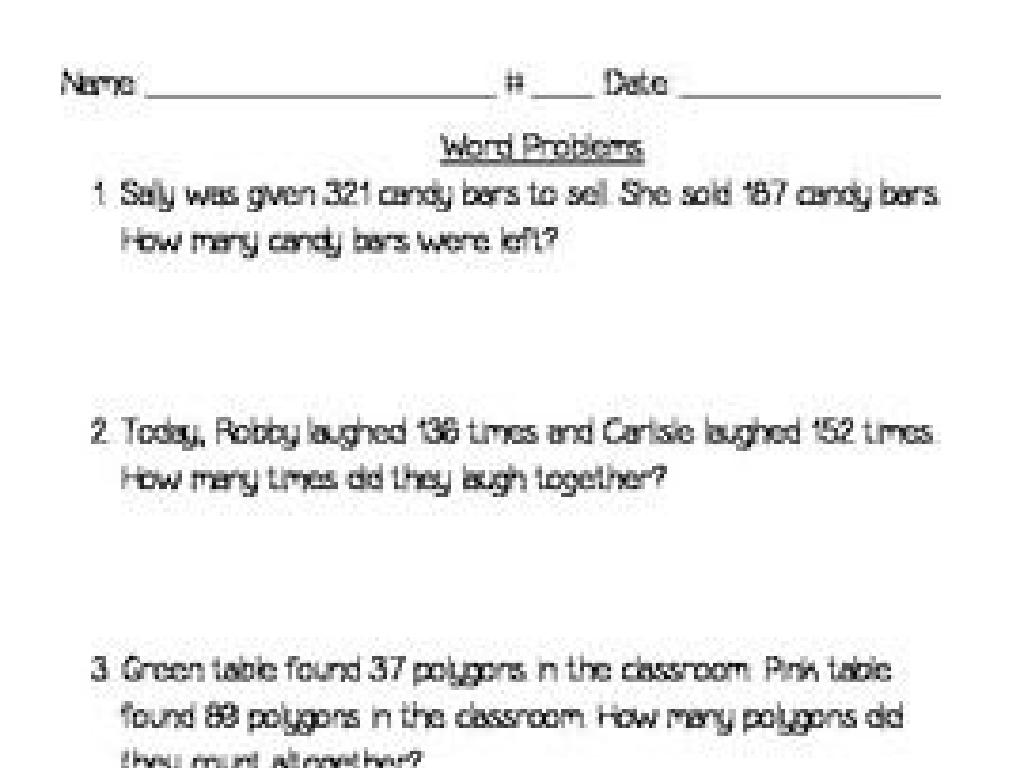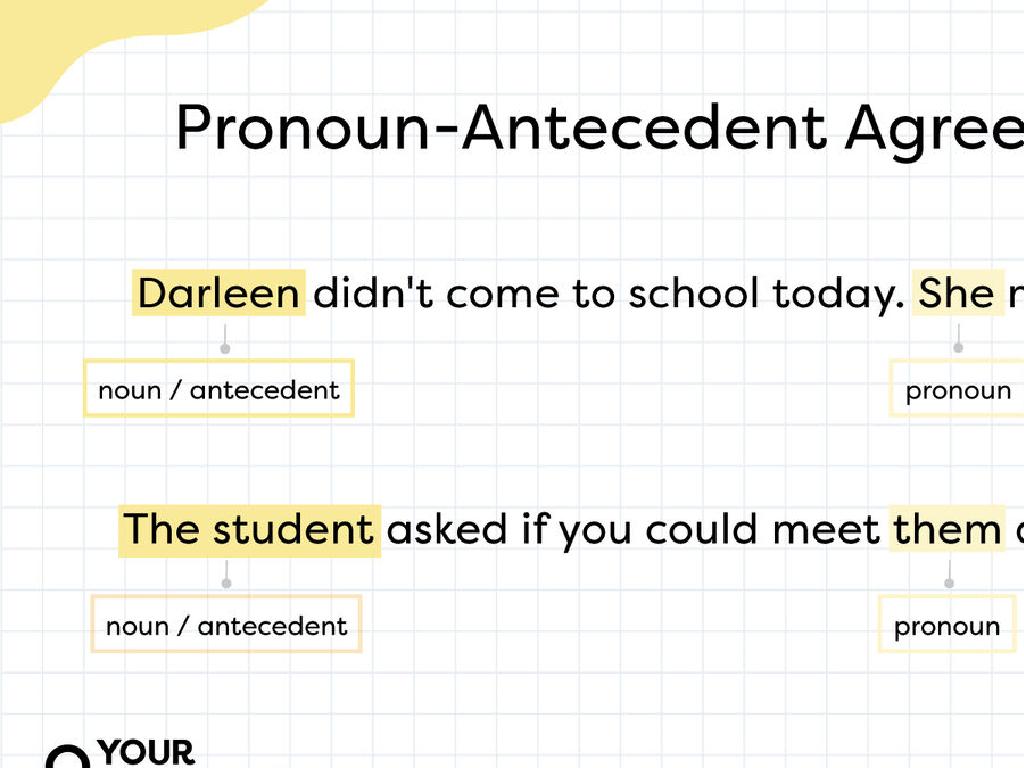Count Forward - Up To 100
Subject: Math
Grade: Kindergarten
Topic: Numbers And Counting To 100
Please LOG IN to download the presentation. Access is available to registered users only.
View More Content
Welcome to Numbers!
– Greet our little mathematicians
– Today’s focus: Learning to count
– Understanding numbers and their order
– Counting journey: Up to 100
– We’ll use songs, games, and objects to count
– Exciting counting adventures ahead
|
This slide is designed to introduce Kindergarten students to the concept of counting up to 100. Start with a warm greeting to make the children feel comfortable and excited about math. Explain that counting is an essential skill and today’s lesson will focus on understanding the sequence of numbers all the way up to 100. Use engaging methods like counting songs, interactive games, and physical objects like beads or blocks to help visualize the numbers. The goal is to make counting a fun and interactive experience, encouraging the students to participate actively. Be prepared with a variety of activities to cater to different learning styles and keep the energy high throughout the lesson.
What is Counting?
– Counting is number order
– Like steps on a staircase
– Imagine going up each step with a new number
– Each number is one more
– After 1 comes 2, then 3, and so on
– Practice counting to 100
– Let’s count together from 1 to 100!
|
This slide introduces the concept of counting as a foundational skill in mathematics for Kindergarten students. It’s important to relate counting to a visual and tangible activity like climbing stairs, where each step represents the next number in the sequence. Emphasize that each subsequent number represents an increment of one, just like taking one step at a time. Encourage the students to practice counting as high as they can, ideally up to 100, to help them understand the concept of number order. Activities can include counting objects, singing counting songs, or using number lines. The goal is to make counting feel like a natural and fun activity.
Counting Fun: Numbers 1 to 10
– Counting from 1 to 10
– Let’s learn to count step by step, starting with the smallest numbers.
– Count fingers, toes, or toys
– Look at your hands and feet or pick your favorite toys to count together.
– Practice saying numbers aloud
– Repeat the numbers after me: one, two, three, and so on up to ten.
– Numbers are fun and easy!
|
This slide introduces the concept of counting to young learners in a fun and interactive way. Start by engaging the students with the idea of counting familiar objects like their fingers and toes, or even classroom toys. This helps them relate to the numbers on a personal level. Encourage the children to practice saying the numbers out loud in unison, which aids in memorization through repetition. Emphasize that numbers are not just symbols but represent quantities and are part of everyday life. The goal is to make the children comfortable with the sequence of numbers from 1 to 10, setting a foundation for further numerical learning.
Counting 11 to 20
– Counting up from 11 to 20
– Each number starts with ‘1’
– Numbers 11-20 have a ‘1’ at the beginning, like 11 (eleven), 12 (twelve), etc.
– Count classroom objects
– Let’s count books, pencils, or blocks together!
– Practice makes perfect!
|
This slide is aimed at helping Kindergarten students recognize and practice counting from 11 to 20. Emphasize the pattern that all these numbers start with the digit ‘1’, which can be a fun observation for the kids. Use tangible objects in the classroom such as books, pencils, or blocks to make the counting exercise interactive and engaging. Encourage the students to count out loud together and use their fingers if necessary. The repetition and practice will help solidify their understanding of the number sequence. Be patient and offer praise for effort and participation to build confidence in their counting skills.
Big Numbers: Counting to 100
– Numbers go beyond 20, up to 100
– Discover numbers like 30, 40, 50
– Each big number is a group of 10s
– Just like 10 fingers, 30 is 3 groups of 10 fingers
– Practice counting by tens to 100
– Let’s count together: 10, 20, 30, and so on!
|
This slide introduces kindergarteners to the concept of counting beyond 20 and up to 100. It emphasizes the pattern of numbers in the tens place and helps them understand that larger numbers are simply groups of 10s. Use physical objects like blocks or counters to visually demonstrate groups of 10, which can make the concept more tangible for young learners. Encourage the students to count aloud in groups of 10 to reinforce the pattern and rhythm of counting by tens. This foundational skill will aid them in developing number sense and prepare them for more advanced mathematical concepts.
Let’s Practice Counting to 100!
– Use a number chart for counting
– A chart with numbers 1-100 helps us see the order
– Point to each number together
– We’ll use our fingers to point at each number as we go
– Count aloud as a class
– Our voices together will help us learn the sequence
– Practice makes perfect
|
This slide is designed for a fun and interactive counting activity using a number chart. The chart will serve as a visual aid to help the students understand the sequence of numbers. As the teacher points to each number, the students will follow along and point to their own charts. Counting aloud as a class will help students get comfortable with the number sequence up to 100. It’s important to encourage participation from all students and to go at a pace that allows everyone to keep up. Consider breaking the counting into smaller sections if needed, and repeat the activity to reinforce learning. Celebrate the students’ progress to build confidence and enthusiasm.
Counting by Tens
– Counting by tens is fun
– Start at 10 and add 10 each time: 10, 20, 30…
– Jump from one big number to another
– Imagine hopping on a number line: 10 to 20 to 30…
– Let’s hop and count by tens
– We’ll count together: 10, 20, 30, up to 100
– Practice makes perfect
|
This slide introduces the concept of counting by tens, which simplifies the process of reaching higher numbers. It’s a foundational skill in understanding the base-ten number system. Encourage the children to visualize themselves hopping from one decade to the next on a number line. During the activity, have the students physically hop or clap as they count by tens to reinforce the concept. This kinesthetic approach helps with memorization and makes learning more engaging. As an extension, you can have students practice writing the numbers as they count, or use objects grouped in tens to provide a visual aid.
Climbing the Counting Mountain to 100!
– Understanding the number 100
– It’s a big number with two zeros
– 100 is a counting milestone
– Like reaching the peak of a mountain in numbers
– Using a chart to reach 100
– We’ll point and count each number up to 100
– Celebrating our counting journey
|
This slide introduces the concept of the number 100 to Kindergarten students, emphasizing its significance as a large number and a milestone in counting. Compare the number 100 to reaching the top of a mountain to make it relatable and exciting for the children. Use a large, colorful chart with numbers up to 100, and guide the students to count together, pointing to each number as they go. This visual and interactive approach helps them understand the sequence of numbers and the concept of 100. Celebrate the achievement of reaching 100 to reinforce the idea that learning to count to this number is a significant accomplishment. Encourage the children to share their feelings about reaching ‘the top of the counting mountain.’
Class Activity: Counting Parade
– Get ready for a counting parade
– Each student receives a number
– You’ll hold a number like a parade sign
– Line up for the march
– We’ll form a line like a train
– Count aloud while parading
– We’ll chant numbers in order together
|
This activity is designed to make learning to count up to 100 fun and interactive. Each child will be given a number to hold, which will help them feel personally involved in the counting process. As they march around the room in a line, they will practice counting out loud in sequence, reinforcing their understanding of number order. For the teacher: Prepare numbers on paper or cardstock ahead of time. Make sure to guide the parade to keep the pace appropriate for all students to keep up. Have a few counting songs ready to make it more engaging. Consider variations of the activity where students can swap numbers, count by twos, fives, or tens, or even have a ‘reverse parade’ where they count backward.






